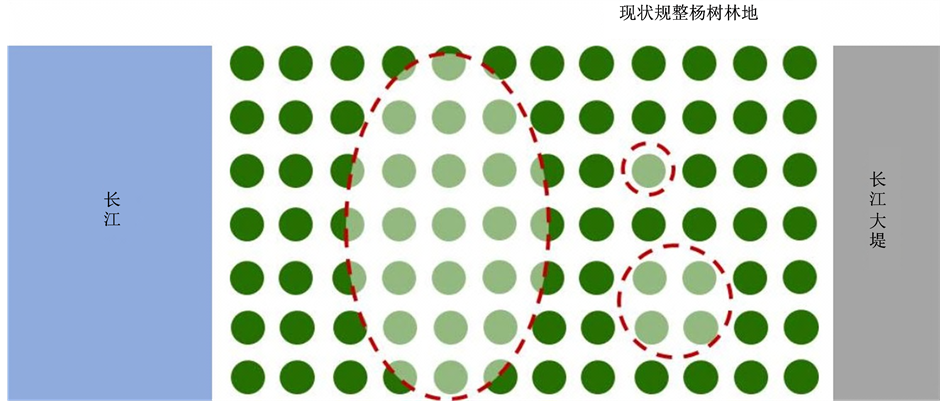1. 引言
我国杨树人工林面积达700万hm2,位居世界第一 [1] 。杨树因其速生和较强的耐淹性,不失为长江江滩绿化造林的优良树种,但同时,大面积的杨树纯林也带来了诸多的生态问题,生物多样性是生态系统稳定的基础 [2] ,也会导致生态系统功能的优化 [3] 。而在生态系统中,生物多样性又是建立在植物多样性的基础之上的 [4] 。单一物种纯林结构导致长江滩涂的生物多样性和生境多样性大大降低,不利于形成自然的乔灌草多层林相结构,难以为多种野生动物如鸟类、爬行类和小型哺乳动物提供优良的栖息环境,降低长江滩涂的生态价值;其次,单一物种纯林抗病虫害能力较差,生态系统安全性堪忧;此外,长时间种植杨树还会导致地力下降,杨树的根际化感作用导致其它植物生长不良,土地生产力和水土保持能力难以维持。针对纯林进行混交化生态修复,建造“近自然森林”,主要优点是可取得单位面积最大的生态效应并通过近自然森林来提高地区的物种群落生态系统以及景观的多样性为动植物提供生存和栖息之地,实现“人与自然和谐发展” [5] 。因此,本文拟以南京江心洲为例,探讨对于长江滩涂区域的杨树纯林进行混交化生态修复改造的方法和途径。
2. 研究地概况与研究方法
2.1. 研究地概况
南京江心洲位于南京市西南部长江中,隶属于建邺区,全洲基本呈南北走向的长条形,面积约15平方公里,西邻长江干流,东侧为夹江,现状长江大堤迎水面一侧滩地面积较大,多为淤积型滩地,土层深厚、土壤肥沃,有机质、矿物质等养分丰富,适宜植物生长。但现状仅洲尾部分分布有一小片天然次生混交林地,其它滩涂区域的林地大部分为林相结构极为单一的杨树或柳树纯林,景观效果不佳,生态价值也较低。
2.2. 研究方法与关键问题
通过多次现场调查和文献研究,比选了林下直接补种目标树种、疏伐杨树补种目标树种以及皆伐杨树林重新造林三个方案,最终确定了疏伐现状杨树营造林窗,在林窗内部补种目标树种的方案。
本方案的关键问题在于现状杨树的疏伐强度与林窗位置的确定、补种目标树种的选择与混交模式的选择。
3. 国内外相关研究
近年来,国内对于杨树混交林营造模式开展了大量研究,芮雯奕等在江苏沿海区域以小苗方式营造杨树-刺槐混交林地 [6] ,研究表明杨树、刺槐的混交林地相比杨树纯林能够有效提升单位面积生产力和土壤肥力。另外,关于杨树与紫穗槐、沙棘、杞柳的混交模式也有较多的研究,混交可以加速林木生长,增加木材产量,减少病虫害发生,提高林分稳定性,同时具有充分利用地力、培肥林地土壤、改善生态环境的良好作用 [7] [8] [9] [10] 。但目前国内对于杨树混交林的模式使用的品种普遍较为单一,并且是以木材产出最主要的目的。笔者认为,长江滩地上的杨树林改造,应当不是以木材产出作为主要目的,而是旨在营造结构更为自然,物种更为丰富的近自然森林。
近几十年来,国际上对于城市林地的修复和营造的研究提倡模仿自然森林群落结构,“宫胁法”是由日本著名生态学家宫胁昭教授提出的一种植被恢复的新理念 [11] :即以生态学的“潜在自然植被”和“群落演替”的基本理论为依据,选择乡土种,即当地自然植被的主要乔、灌木的种类,应用“容器育苗”和“近自然”苗木种植技术,超常速、低造价地营造以地带性森林类型为主,具有群落结构完整、物种多样性丰富、生物量高、趋于稳定状态、后期完全遵循自然循环规律的“少人工管理型”的“近自然森林”。“近自然森林”建设的理念与技术现已在世界各地广泛应用和推广,日本有多个地点,东南亚、南美洲热带地区多个地点已获得成功 [12] 。
“宫胁法”种植的最大特色在于:它所营造出来的是一种完全健康自然的生态环境。不同于传统种植中为了追求经济效益或树种种类,把许多不相干的树种“七拼八凑”堆在一起随意种植,“宫胁”崇尚的是自然的演替,而非人工的造作,就像一个自然的生态小环境一样。按照这一理论,只需花上4、5年时间就可以形成在自然环境下要50~100年时间才能演替成形的灌木林外貌,是一种人工营造与自然生长完美结合的全新种植理念。笔者认为,“宫胁法”造林模式对于本项目杨树林的混交改造具有一定的指导和借鉴意义。
4. 研究结果和分析
4.1. 现状杨树的生态疏伐
由于现状杨树林地较密,郁闭度达到90%以上,江滩区域适生的物种以阳性的落叶树种为主,相关研究表明,光是影响植物生长和死亡的关键资源,光照不足会影响乡土种入侵人工林 [12] ,因此,如果保留全部现状的杨树,直接在杨树林下种植目标植物物种将很难达到林相改造的目的。
但同时,改造区域位于长江江滩,滩涂沿江一侧受到江水的冲刷侵蚀较为严重,目前,滩地的第一排和第二排杨树根系均有外露现象,此区域的生态环境较为脆弱,不适宜对现状的杨树进行砍伐。另外,江滩区域风力较大,如果将现状杨树进行皆伐,则新种的树木小苗将直接面对江滩的大风干扰,成活率将大大降低,因此,对现状杨树进行完全的皆伐,也不是适合江滩区域杨树林改造的方式。
根据现场条件,制订生态疏伐杨树林的方案,保留沿江第一排和第二排的杨树,按照30%~50%强度疏伐临近堤岸一侧的现状杨树,在现状杨树纯林中形成一定面积的人工林窗区域,为新的混交林地种植提供适宜的日照条件与发展空间(如图1所示)。
4.2. 混交植物群落种植
混交植物群落种植主要涉及到两个方面,即选择什么样的树种和通过怎样的混交模式进行栽植,才能保证较高的成活率和最佳的成林效果。
4.2.1. 混交模式的选择
如何进行补植工作决定了优化后森林的方向,不同的造林方法形成的森林各有不同,本文比较了传统规则造林法以及随机造林法这两大类混交造林模式,并基于对“宫胁法”造林模式的研究与借鉴,本文认为完全随机混交造林法适合中小尺度下长江滩地杨树纯林的改造(如下图2,表1)。
4.2.2. 适宜植物物种的选择
南京江心洲长江滩涂区域受到长江水位的影响,每年的7~9月,滩涂林地都会发生季节性的淹没,淹没范围和深度随着每年的洪水水位而变化,因此,滩涂林地植物物种的选择首先要考虑其耐淹性,同时应避免使用外来入侵物种,滩涂土壤还存在着轻微的盐碱性特征,这一点在物种选择上也是一项考虑因素。在多次现场踏勘中,我们发现杨树林下分布有少量如桑树、苦楝、丝绵木等物种,但可能由于杨树对于阳光资源的遮挡生长状况不佳,这一些物种是潜在的修复目标物种,此外,江滩上存在着血吸虫的问题,部分植物如枫杨等可有助于防治血吸虫,从植物群落的角度出发,所选择的植物物种应能够搭配形成较为稳定的植物群落结构。同时,景观效果如开花、色叶也是植物选择的重要考虑因素。
因此,选择如下表2所示的植物物种,确定枫杨、苦楝、江南桤木、旱柳、桑树、乌桕和喜树为主要树种,作为混交小团的优势种和亚优势种,并根据生态位理论,综合考虑景观效果,搭配构建6种植物营造小团,用于人工构建林窗区域的植物群落营造。所选的植物物种,按照表中所选定的数量比例,以1~5 cm地径的小苗规格用于滩地区域的混交造林,种植模式采取小团内随意混交,平均造林密度选择约1株/平米。

Figure 1. Thinning of existing pure poplar forest
图1. 杨树林生态疏伐方案示意

Figure 2. Different afforestation methods
图2. 各造林混交模式示意

Table 1. Assessment and selection and selection of different afforestation methods
表1. 各造林混交模式比较和选择

Table 2. Plant species selection and community group recommendation
表2. 植物物种选择及营造小团搭配
Continued
4.3. 抚育与管理
设计于秋季落叶后进行树木种植,在混交林营造的前3~5年,实施苗木生长状况监测和每年3次的森林抚育,由于种植密度较大,鼓励在林地的发育过程中发生自然选择过程,借“自然之手”形成人工手法无法实现自然的群落结构,仅在树苗发生大面积死亡的情况下才进行苗木补植。由于长江滩地这一特殊的地理位置,同时需要在每年的洪水淹没过程之后,进行苗木生长状况的调查监测。
3~5年后可期待形成较为稳定的群落结构,可以考虑清理部分生长状况较为不佳的植物,为生长状况良好的树木提供更大的发展空间。
5. 总结
本文分析了长江滩涂区域杨树纯林的生态修复设计,提出了疏伐杨树纯林,人工创造“林窗”,参考“宫胁造林法”在林窗中通过将本地适生物种以群落小团的方式密植混交的方式,营造近自然混交林地。其中,林窗位置的选定,混交模式的选择,适应长江滩地水文与土壤条件的植物物种的选择以及林地的管理维护是本设计的难点。在长江滩涂上对杨树纯林进行多种植物物种的混交改造,在国内属于首创设计。笔者将持续跟踪监测改造的进程和植物群落结构的变化发展,以期为中国大面积的杨树纯林改造提供一种新的方向和思路。